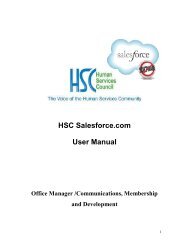BLUEPRINT
Blueprint for Neighborhoods - United Neighborhood Houses
Blueprint for Neighborhoods - United Neighborhood Houses
- No tags were found...
Create successful ePaper yourself
Turn your PDF publications into a flip-book with our unique Google optimized e-Paper software.
3.5 Designate a Mayoral appointee responsible for the City’s workforce development<br />
strategy, supported and informed by a broad-based council of advisors.<br />
Committing to an integrated workforce development strategy for the City will<br />
promote better outcomes for New Yorkers in need of job training and employment<br />
opportunities. This appointee will coordinate all local, State, Federal<br />
and philanthropic resources available to City agencies that provide workforce<br />
development services.<br />
3.6 Commit the City’s Workforce1 Centers to serving all New Yorkers in need of employment<br />
services, including individuals who face significant barriers. Modifying<br />
the mission of Workforce1 centers to better accommodate individuals who lack<br />
a high school diploma or have a criminal justice record is necessary to ensure<br />
limited Federal resources are targeted to assist those with the highest need.<br />
3.7 Enact a local law that bars employers from discriminating against individuals<br />
based on their credit history. This protection for workers will ensure that job<br />
seekers and current employees are not unfairly penalized for credit reports<br />
that often contain errors, reflect financial duress as a result of the Recession,<br />
and do not reflect an applicant’s qualifications.<br />
3.8 Enact a local law that protects job seekers from employment discrimination<br />
based on arrest record or criminal convictions. This worker protection will<br />
ensure that job applicants are able to compete for employment based on their<br />
merit and not be dismissed out of hand by employers. This change is necessary<br />
to break the cycle of incarceration, inability to secure employment and<br />
eventual re-incarceration in many communities.<br />
C. Build, Support, and Sustain Healthy, Livable and Inclusive Communities<br />
Healthy, stable, and inclusive neighborhoods depend upon certain critical elements<br />
of community infrastructure. This section outlines recommendations to<br />
address inequities between communities citywide and other policies that will<br />
allow low-income neighborhoods to thrive. Informed by UNH members’ track<br />
record of supporting vibrant communities, this set of policies will improve<br />
health and mental health, sustain affordable housing, support older adults,<br />
provide immigrants with a voice in their communities, and improve residents’<br />
relationships with law enforcement and the criminal justice system.<br />
4. Health and Mental Health<br />
4.1 Expand school-based health centers to operate on every school campus and in<br />
community-based organizations. By expanding school-based health centers to<br />
every school campus, tens of thousands of children and youth can receive crucial<br />
preventive and primary health care at a critical time in their development.<br />
4.2 Fund community-based health programs. Community-based organizations<br />
like settlement houses provide culturally and linguistically appropriate services<br />
for their communities. Embedding health services at community-based<br />
organizations allows residents to access “wrap-around” human services.<br />
4.3 Expand the Children Under Five Initiative. Diagnosing and treating mental health<br />
problems early in life helps children grow and succeed in school. Expanding mental<br />
health services for children under five years of age will ensure that issues of<br />
trauma and mental health disorders are identified and addressed early on.<br />
Comprehensive Support Services for Older Adults<br />
4.4 Double funding for case management for seniors. Rather than requiring<br />
seniors to leave their homes to receive the services they need, the case<br />
management approach deploys social workers to visit older adults’ homes.<br />
Blueprint for Neighborhoods 2013 6




